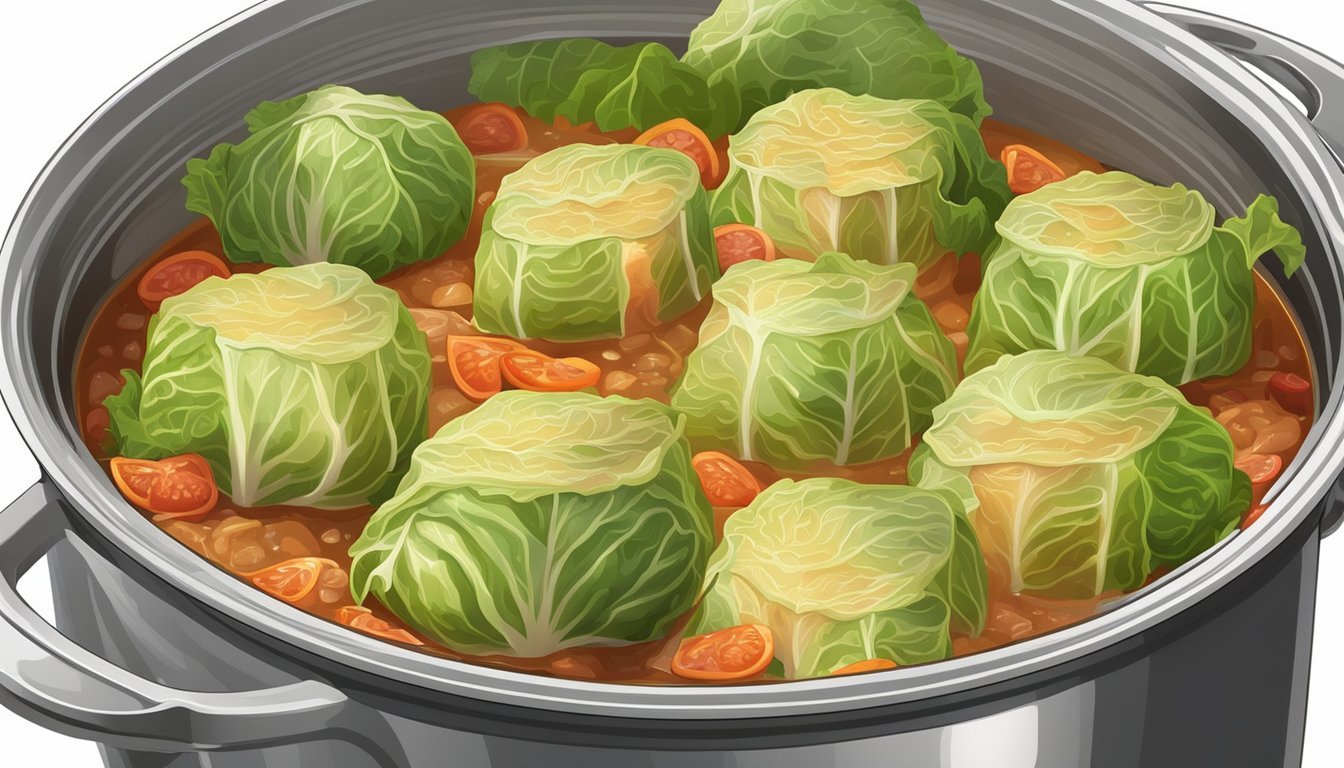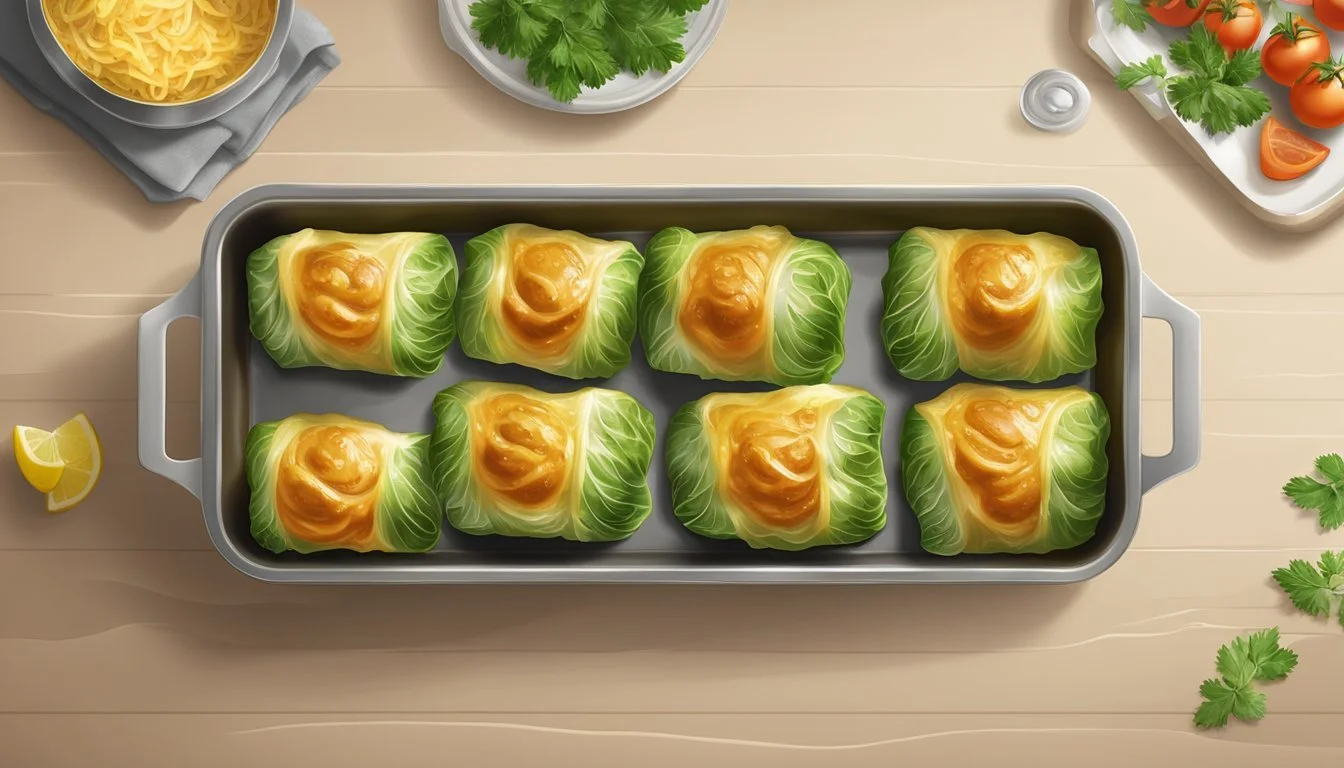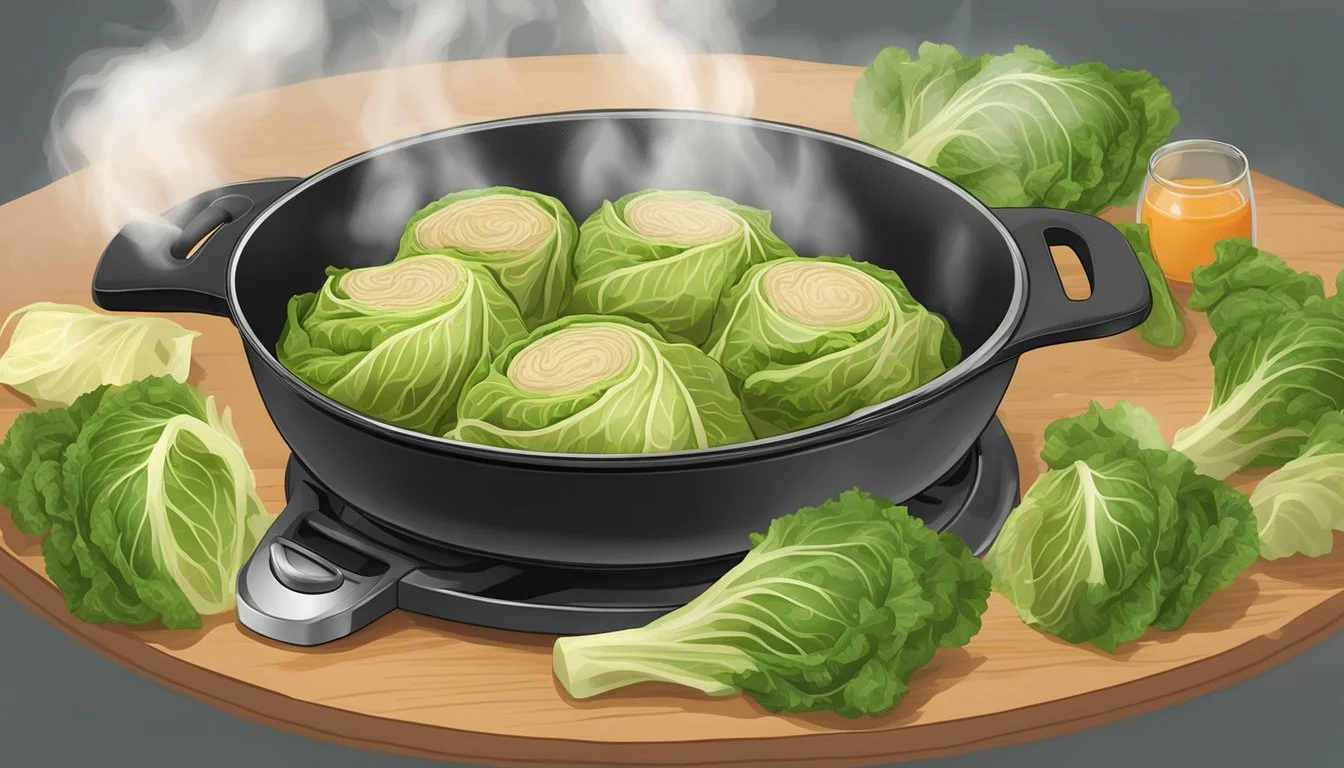Best Way to Reheat Stuffed Cabbage Rolls
Tips for Preserving Tenderness and Flavor
Introduction to Cabbage Rolls
Cabbage rolls are a traditional dish made with cabbage leaves wrapped around a filling, typically containing meat and rice. They are a popular comfort food that can be served as a main course or as a side dish. The delicious flavor and texture of cabbage rolls can be enhanced by using various ingredients such as garlic powder, ground pork, and tomato sauce. The combination of tender cabbage leaves and savory filling creates a delightful culinary experience. To enjoy cabbage rolls at their best, it’s essential to reheat them properly, especially when dealing with leftover cabbage rolls. Proper reheating ensures that the rolls remain moist and flavorful, preserving the integrity of the dish.
Tips for Preserving Tenderness and Flavor
Stuffed cabbage rolls, a dish enjoyed across various cultures, epitomize comfort food with their tender meat and savory filling encased in soft leaves. The challenge of reheating this delicacy lies in preserving the texture of the leaf wrapper and ensuring that the filling remains moist and flavorful. Achieving the right balance of heat, moisture, and time is key to reviving cabbage rolls to their original state without ending up with a dried-out or soggy result.
The oven and stovetop methods are the most recommended approaches for heating stuffed cabbage rolls, as they provide a gentle and even rewarming process. An oven set to a moderate temperature allows the rolls to heat through gradually, which is essential for maintaining their structure and taste. On the other hand, using the stovetop with a bit of added moisture can aid in keeping the rolls juicy. Care must be taken to cover the rolls during the reheating to create a steamy environment that aids in retaining their succulence.
Understanding the subtleties of each reheating method allows one to enjoy stuffed cabbage rolls that taste freshly made. It's about more than just warming up leftovers; it's about restoring them to their peak form, making the dish satisfying and enjoyable anytime.
Understanding Cabbage Rolls
Cabbage rolls are a beloved dish consisting of cooked cabbage leaves wrapped around a variety of fillings. Their preparation is pivotal to their final taste and texture, and the method of reheating can greatly affect their integrity.
Composition and Structural Integrity
The composition of cabbage rolls typically includes a mixture of ground meat, rice or grains, and seasonings, all encased in a leaf of cabbage. The diverse vegetable components, including the cabbage leaf and any additional vegetables in the filling, contribute significantly to the flavor and texture of the dish. Ensuring the cabbage leaf is sufficiently blanched makes it pliable for wrapping without tearing. The structure of a cabbage roll is critical; it should be tight enough to hold the filling in place while maintaining its shape during the cooking and reheating processes.
Key Components:- Cabbage Leaf: Provides the outer shell and is crucial for structural integrity.
Filling: Often a mix of ground meat, grains like rice, and spices.
Sauce: Commonly tomato-based, adding moisture and flavor.
The rolls are often baked or simmered in a sauce which contributes moisture, and helps to meld the flavors of the roll’s components. This cooking liquid also plays a vital role in the reheating process to prevent drying out.
Impact of Reheating on Taste and Texture
When reheating cabbage rolls, one must be cautious to preserve the taste and texture that make the dish so comforting. Heat must penetrate to the center of the roll without causing the outer cabbage layer to become too soft or soggy. Precisely such factors, like the different ingredients requiring specific cooking times, necessitate a uniform heating approach to avoid overcooking.
Texture: Should remain tender, with the filling staying moist, not drying out or becoming too crumbly.
Taste: Reheating should enhance the flavors, allowing the spices in the meat and grains to become more pronounced.
Reheating methods vary but commonly include the oven and stovetop. The oven is preferred for even warming, usually at 350 degrees Fahrenheit. Covering the rolls in aluminum foil with added cooking liquid helps in retaining moisture and preventing dryness. On the stovetop, a gentle heat with a covered pan and a splash of sauce can reheat the cabbage rolls thoroughly while keeping them moist. Careful monitoring during reheating ensures an optimal eating experience.
Pre-Reheating Preparation
Proper preparation is essential to ensure stuffed cabbage rolls maintain their tenderness and savory flavor during reheating. Attention to thawing procedures and moisture retention strategies can make all the difference.
Thawing Cabbage Rolls
For frozen cabbage rolls stored in the freezer, they should be moved to the fridge at least 24 hours before reheating to allow them to thaw gently. This slow thawing process prevents the formation of ice crystals, which can degrade the texture and lead to freezer burn.
Step-by-Step Thawing Guide:- Step 1: Transfer the frozen cabbage rolls from the freezer to the fridge.
Step 2: Place them in an to prevent contamination.
Step 3: Allow them to thaw for 24 hours to ensure even reheating.
Preventing Dryness and Freezer Burn
Stuffed cabbage rolls are susceptible to dryness and freezer burn if not stored correctly. Preventing these issues starts with proper storage techniques.
Storage Tips:
Wrap the rolls individually in cling film to seal in moisture.
Use an airtight container or heavy-duty freezer bags to protect them from air exposure.
Label the container with the date to keep track of storage duration and ensure quality.
By wrapping cabbage rolls and storing them carefully, one can prevent dryness and protect the quality of the meat and filling. It is crucial to maintain moisture levels for the best reheating results.
Reheating Methods
When it comes to reheating stuffed cabbage rolls, the goal is to warm them thoroughly while maintaining their tenderness and taste. Utilizing the right method ensures the filling stays savory and the meat remains tender. Below are detailed methods for reheating stuffed cabbage rolls.
Oven Reheating Technique
For the oven method, preheat the oven to 350 degrees Fahrenheit. Place the cabbage rolls in an oven safe dish, pour a bit of water or tomato sauce around them for moisture, and cover with aluminum foil to keep them from drying out. Heat them for approximately 20-30 minutes. It’s essential to check that the internal temperature reaches 165°F before serving. Use oven mitts or heat-resistant gloves when handling the hot tray.
Microwave Reheating Instructions
To reheat in the microwave, place the cabbage rolls in a microwave-safe container. Add a splash of water or sauce to prevent drying out. Cover with a microwave-safe lid or cover. Use a medium power setting and heat for about two minutes, then check if they need more time. Reheat in short intervals, using brief bursts while stirring to prevent overcooking. This method is quick but might not heat as evenly as the oven technique.
Stovetop Method
The stovetop approach involves placing the cabbage rolls in a pan with a small amount of liquid (water or sauce) and covering with a lid. Heat over a medium heat setting, and allow them to warm up gently, usually for about 10-15 minutes, checking frequently. This can create a steaming effect that helps the rolls retain moisture.
Alternative Reheating Methods
Other reheating techniques include using an air fryer if available. The air fryer can provide a crisper exterior if desired. Set it to a moderate temperature and heat the rolls for a few minutes, checking periodically to prevent overcooking. Alternatively, you can reheat the cabbage rolls in a pan and gently turn them every few minutes to achieve even warmth and a desirable crunch.
Advanced Reheating Techniques
Advanced reheating techniques for cabbage rolls involve using various methods to achieve a perfect warm state. One effective technique is to bake the cabbage rolls in a baking dish covered with foil, which helps to retain moisture and flavor. Another method is to reheat the cabbage rolls in a pan with a small amount of oil or broth, gently turning them every few minutes to achieve a tasty crunch. It’s also essential to use the right temperature and cooking time to avoid overcooking the center stage vegetable. By using these advanced reheating techniques, you can enjoy delicious leftover cabbage rolls that are both healthy and flavorful.
Gauging Temperature and Safety
Ensuring the proper internal temperature and adhering to food safety standards are crucial when reheating stuffed cabbage rolls. Using a food thermometer can verify that the meat and savory fillings reach a safe consumption point, while following safety considerations helps prevent foodborne illnesses.
Using Food Thermometers
To guarantee that reheated cabbage rolls are safe to eat, they should reach an internal temperature of 165°F. This temperature ensures that any potential harmful bacteria present in the meat filling are destroyed. A food thermometer should be inserted into the center of the cabbage roll for an accurate reading. It's important not to rely on external signs of heat, such as steam, as these don't ensure that the core is thoroughly heated.
Proper Usage of Food Thermometers:
Insert the thermometer midway inside the thickest part of the cabbage roll.
Wait for the thermometer to provide a steady reading.
Make sure to clean the thermometer before and after use to avoid cross-contamination.
Food Safety Considerations
When handling and reheating stuffed cabbage rolls, several safety considerations should be taken into account.
Storage: Cabbage rolls should be stored in the refrigerator within two hours of cooking to inhibit the growth of bacteria. They should be kept in airtight containers and can be safely refrigerated for 3-4 days.
Reheating: When reheating, one should ensure that the entire dish reaches 165°F to maintain food safety. Even heat distribution can be achieved by covering the rolls with foil during the reheating process in the oven.
Cross-Contamination: It's essential to prevent cross-contamination by using separate utensils for raw and cooked foods and by using clean containers for storage.
By maintaining these safety standards, individuals can enjoy their reheated cabbage rolls knowing they have minimized the risk of foodborne illness.
Enhancing the Reheated Cabbage Rolls
Enhancing the reheated cabbage rolls not only rejuvenates their flavors but also elevates their presentation. A thoughtful approach to garnishing and serving can significantly enhance the dining experience.
Garnishing and Presentation Tips
Garnishing reheated cabbage rolls adds both visual appeal and a burst of fresh flavor. Here are specific tips to make them look and taste great:
Fresh Herbs: Sprinkle finely chopped parsley or dill on top of the cabbage rolls after reheating. This adds a fresh element and vibrant color contrast.
Sour Cream: A dollop of sour cream can be added just before serving for added richness.
Lemon Zest: Grate a small amount of lemon zest over the rolls for a hint of citrus.
By focusing on these simple yet effective garnishes, one can greatly enhance the overall appeal of the dish.
Serving Suggestions and Accompaniments
Pairing cabbage rolls with the right sides and accompaniments can create a more fulfilling meal. Here are recommended suggestions:
Grains: Serve cabbage rolls alongside a portion of fluffy rice or mashed potatoes to absorb the delightful sauces.
Vegetables: Roasted or steamed vegetables such as carrots, peas, or broccoli complement the flavors well.
Offering these accompaniments not only balances the meal but also caters to a variety of taste preferences.
Managing Leftovers
When dealing with leftover stuffed cabbage rolls, one should consider the best practices for storing and freezing to maintain their quality. Proper storage prevents spoilage and ensures that the rolls retain their flavor and texture upon reheating.
Storing Leftover Cabbage Rolls
Properly storing leftover cabbage rolls is crucial for maintaining their freshness and preventing contamination. To store them in the refrigerator:
Let the cabbage rolls cool to room temperature.
Transfer the rolls to an airtight container to prevent them from absorbing odors and to maintain moisture levels.
Store in the refrigerator for up to 3-4 days.
Freezing Instructions for Future Consumption
Freezing is a practical option for extending the shelf life of leftover stuffed cabbage rolls. To freeze cabbage rolls effectively:
Ensure that the cabbage rolls have cooled completely after cooking.
Place the cabbage rolls in a single layer on a baking sheet to freeze evenly before transferring them to an airtight container.
Wrap each roll individually in plastic wrap to prevent freezer burn and then place them in an airtight container or a heavy-duty freezer bag
Label the container or bag with the date to keep track of how long the rolls have been stored.
Cabbage rolls can be frozen for up to 3 months. When ready to use, one can thaw them overnight in the refrigerator before reheating.
By following these storage and freezing guidelines, leftover stuffed cabbage rolls will remain a delicious and convenient meal option for the days or months ahead.
Common Reheating Mistakes to Avoid
When reheating cabbage rolls, there are several common mistakes to avoid. One of the worst things you can do is to overcook the cabbage rolls, which can result in a mushy texture and a foul smell. Another mistake is to use excessively hot heat, which can cause the cabbage structure to fall apart and dry out. It’s also essential to avoid reheating cabbage rolls in the microwave without proper covering, as this can lead to uneven heating and a loss of texture and flavor. By avoiding these common mistakes, you can enjoy perfectly reheated cabbage rolls that are both delicious and healthy. Additionally, using the right ingredients, such as sour cream or garlic powder, can enhance the flavor and texture of the cabbage rolls. Furthermore, understanding the factors that explain the best reheating method, such as the type of filling and the cooking required, can help you to achieve a perfect reheating result.
Additional Information
In this section, readers will find specialized advice for warming up larger quantities of stuffed cabbage rolls, a clear procedure for reheating to ensure optimal texture and taste, and answers to common questions that may arise during the process.
Handling Large Portions
When reheating a large batch of stuffed cabbage rolls, one should ensure even heating without drying out the meat. To accommodate larger volumes, it is best to heat the rolls in batches if the oven space is limited. One might need to increase the heating time slightly, depending on the oven’s capacity and the amount being reheated.
Step-by-Step Guide to Reheating
Reheating stuffed cabbage rolls requires careful attention to preserve their flavor and moisture:
Preheat the oven to 350°F (175°C).
Place the cabbage rolls in a baking dish.
If the rolls contain ground beef, ensure the internal temperature reaches 165°F for safety.
Add a layer of tomato sauce over the rolls to maintain moisture and enhance flavor.
Cover the dish with aluminum foil to prevent drying out.
Heat for 30-45 minutes or until the internal temperature indicates they are heated thoroughly.
Can I use a microwave to reheat cabbage rolls? Yes, although it might not retain the texture as well as oven reheating. Use a microwave-safe dish, cover it, and heat in intervals, checking for even warmth.
How do I store leftover cabbage rolls? Store them in an airtight container in the refrigerator. They can typically last up to 3-4 days when stored properly.
Is it safe to reheat cabbage rolls more than once? It is generally advised to reheat only the portion you plan to consume. Multiple reheats can degrade texture and may increase the risk of foodborne illness.




